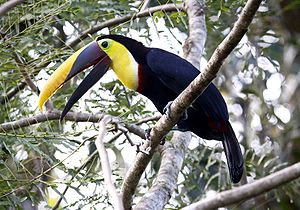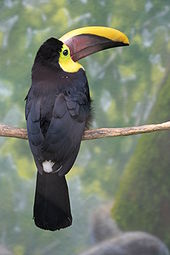- Chestnut-mandibled Toucan
-
Chestnut-mandibled Toucan 
At Drake Bay, Costa Rica. Conservation status Scientific classification Kingdom: Animalia Phylum: Chordata Class: Aves Order: Piciformes Family: Ramphastidae Genus: Ramphastos Species: R. swainsonii Binomial name Ramphastos swainsonii
Gould, 1833The Chestnut-mandibled Toucan, or Swainson’s Toucan (Ramphastos swainsonii) is a near-passerine bird which breeds from eastern Honduras to northern Colombia to western Ecuador. This species is replaced from southern Colombia to eastern Peru by the closely related Black-mandibled Toucan, R. ambiguus, with which it is sometimes considered conspecific. The scientific and alternative English names commemorate the English ornithologist and artist William Swainson.
Contents
Description
Like other toucans, the Chestnut-mandibled is brightly marked and has a large bill. The male is 56 cm long, while the smaller female is typically 52 cm long. Weight ranges from 599 to 746 grams (1.3-1.6 lbs).[1]
The sexes are alike in appearance, mainly black with maroon hints to the head, upper back and lower breast. The face and upper breast are bright yellow, with narrow white and broader red lines forming a lower border. The upper tail is white and the lower abdomen is red. The legs are blue. The body plumage is similar to that of the smaller Keel-billed Toucan, but the bill pattern is quite different, being diagonally divided into bright yellow and maroon.
Juvenile birds are sooty-black, and have duller plumage, particularly with respect to the bib, red border, and lower mandible. They are fed by the parents for several weeks after leaving the nest.
The call of the Chestnut-mandibled Toucan is a yelping yo-YIP, a-yip, a-yip, or a Dios te dé, Dios te dé (Spanish for "God give you..."). It is given to maintain contact as the flock travels in "follow-my-leader" style through the trees, but also in chorus at the evening roosts.
Behavior
Small flocks, usually consisting of 3-12 birds, move through the forest with an undulating flight, rarely travelling more than 100 m at a time. This species is primarily an arboreal fruit-eater, but will also take insects, lizards, small birds and frogs. Flocks will follow Keel-billed Toucans to exploit their sources of food.
Reproduction
The Chestnut-mandibled Toucan is a resident breeder in moist lowland forest. The 2-4 white eggs are laid in an unlined cavity high in a decayed section of a living tree, or occasionally in an old woodpecker nest in a dead tree.
Both sexes incubate the eggs for at 14–15 days, and the toucan chicks remain in the nest after hatching. They are blind and naked at birth, and have short bills and specialised pads on their heels to protect them from the rough floor of the nest. They are fed by both parents, and fledge after about 6 weeks.
Aviculture
Chestnut-mandibled Toucans are sometimes kept as pets. They are the most readily-available 'large toucan' species available in aviculture in the USA, however they are considered to be noisy, when compared to other toucans.[2] It is illegal to take toucans or any other protected wild bird species from their nests.
References
- BirdLife International (2004). Ramphastos swainsonii. 2006. IUCN Red List of Threatened Species. IUCN 2006. www.iucnredlist.org. Retrieved on 11 May 2006. Database entry includes justification for why this species is of least concern
- F. Gary Stiles & Alexander F. Skutch (1989). A Guide to the Birds of Costa Rica. ISBN 0-8014-9600-4.
- Steven L. Hilty (2003). Birds of Venezuela. ISBN 0-7136-6418-5.
- ^ http://www.nashvillezoo.org/piciformes/ramphastidae.htm
- ^ Summers, Amado. "Toucans!". Organization of Professional Aviculturists, Inc.. http://www.proaviculture.com/toucans.htm. Retrieved 19 May 2010.
External links
- Extensive Gallery on Toucans
- List of Toucans
- Toucan videos on the Internet Bird Collection
- Bibliography of online, ornithological articles which explore the natural history of the Toco toucan, Ramphastos toco toco.
- Information on and sounds of the Chestnut-mandibled or Swainson's toucan, Ramphastos swainsonii.
Toucans, toucanets, and araçaris (family: Ramphastidae) Genus Aulacorhynchus
(green toucanets)Selenidera
(dichromatic toucanets)Andigena
(mountain toucans)Grey-breasted Mountain Toucan • Hooded Mountain Toucan • Plate-billed Mountain Toucan • Black-billed Mountain ToucanPteroglossus
(araçaris or aracaris)Saffron Toucanet • Green Aracari • Lettered Aracari • Collared Aracari • Black-necked Aracari • Chestnut-eared Aracari • Many-banded Aracari • Ivory-billed Aracari • Curl-crested Aracari • Red-necked Aracari • Brown-mandibled Aracari • Fiery-billed Aracari • Stripe-billed Aracari • Pale-mandibled AracariRamphastos
(true toucans)Keel-billed Toucan • Choco Toucan • Channel-billed Toucan • Red-breasted Toucan • Chestnut-mandibled Toucan • Black-mandibled Toucan • White-throated Toucan • Toco ToucanCategories:- IUCN Red List least concern species
- Ramphastos
- Birds of Costa Rica
- Birds of Colombia
- Birds of Ecuador
- Birds of Honduras
- Birds of Nicaragua
- Birds of Panama
- Birds of Peru
- Birds kept as pets
Wikimedia Foundation. 2010.




